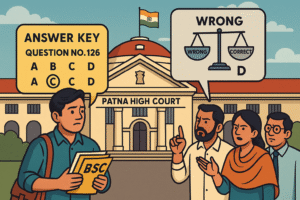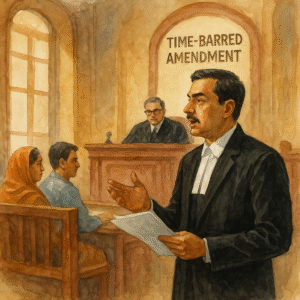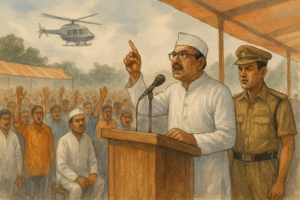The Patna High Court (Division Bench) has set aside the conviction and death sentences awarded to three men in a 2012 case from Purnea district involving the rape-and-murder allegation of a 13-year-old village girl. Deciding a death sentence reference alongside the connected criminal appeals, the Court held that the prosecution failed to prove a complete and reliable chain of circumstances, and that the trial court’s conclusions were based on inadmissible or untrustworthy material. Consequently, the appeals were allowed, the conviction and sentences were quashed, and the death reference was rejected.
In plain terms, the High Court said: the crime was undoubtedly ghastly, but without legal and trustworthy evidence, the accused could not be convicted—let alone sent to the gallows. The Court ordered the release of the appellants unless required in another case.
The case reached the High Court as a “Death Reference” after a Purnea Sessions Court, by judgment dated 07.02.2018 and order dated 15.02.2018, had convicted the accused of murder with common intention (Section 302/34 IPC), gang rape (Section 376(2)(g) IPC), and criminal conspiracy (Section 120-B IPC), awarding the death penalty for murder and life imprisonment for the other counts.
The Division Bench comprising Hon’ble Mr. Justice Ashwani Kumar Singh (authoring the oral judgment) and Hon’ble Mr. Justice Arvind Srivastava re-appreciated the record and concluded that the prosecution’s case—based entirely on circumstances—did not meet the settled legal standards for a conviction.
The prosecution story began with an FIR against unknown persons after the child’s body was discovered in a maize field on 11–12 May 2012. No eyewitness ever claimed to have seen the offence or the accused near the place of occurrence. The investigation relied on alleged police confessions and a disclosure-led recovery of a knife, along with forensic reports. However, the High Court found multiple gaps: there was no “last seen” evidence linking the accused to the victim; key scientific links were missing; and the statements most relied upon were either inadmissible or later retracted/unsupported at trial.
Simplified Explanation of the Judgment
This judgment is about whether the prosecution proved, beyond reasonable doubt, that the accused were responsible for the assault and murder. The High Court explained that when there is no eyewitness, the law allows conviction on circumstantial evidence—but only if each individual circumstance is proved and all of them, together, form a complete chain that points only to the accused and excludes every other hypothesis. The Court cited classic Supreme Court rulings laying down this standard.
Here, the prosecution failed on several critical counts:
- No eyewitness and no “last seen” link. The FIR was against unknown persons. Not a single witness placed the accused with the child on the fateful day or at/near the maize field before or after the incident. The supposed “last seen” account with another person (not among the appellants) did not support the prosecution against the appellants.
- Unreliable statements and hostile witness. A child witness (whose Section 164 CrPC statement had been heavily relied upon during investigation) turned hostile at trial and denied knowledge. The Court reiterated that a Section 164 statement is not substantive evidence, and in this case it did not provide a safe foundation for conviction.
- Confessions recorded by police were inadmissible and unsafe to rely upon. The trial court had leaned on police-recorded confessional statements and the alleged recovery of a knife. The High Court held that this material, as presented, did not legally establish the prosecution’s case; the chain remained incomplete.
- Forensic shortcomings broke the chain. The FSL noted bloodstains on several exhibits and semen on undergarments. But the prosecution did not collect the victim’s blood for grouping and comparison, a vital omission that “grossly damaged” the case and undermined the credibility of the forensic narrative. Hair samples lacked roots, making individualization impossible. As the Court summarized, the expert reports did not, in any way, provide proof to establish the accuseds’ guilt.
- Speculative motive and conspiracy. With no eyewitness and no consistent last-seen evidence, the allegation of conspiracy rested on the mere assertion that multiple persons had acted together. The Court found this to be an erroneous presumption by the trial court, unsupported by admissible facts.
Given these deficiencies, the High Court stressed an important principle: even in the face of a brutal crime that shocks the conscience, courts must convict only on legal, cogent, and unimpeachable evidence. Suspicion—however strong—cannot replace proof. The “mental distance” between “may be true” and “must be true” must be covered by clear proof before a person is condemned as a convict, much less executed.
Accordingly, the Bench allowed all connected criminal appeals, set aside the conviction and sentences, acquitted the appellants of all charges, directed their release, and rejected the death reference.
Significance or Implication of the Judgment (For general public or government)
For the public, this ruling underlines a core safeguard: no one can be convicted—especially not sentenced to death—on the basis of guesswork, rumours, or incomplete forensics. The Court’s approach insists on dependable links: reliable witness testimony, properly collected and compared forensic samples, and legally admissible statements. When these are missing, courts must acquit.
For investigators and prosecutors, the case is a reminder that scientific rigor matters. Failing to collect the victim’s blood sample for grouping and not establishing the origin of hair samples fatally weakened the case. The message is clear: Follow forensic protocols meticulously, ensure chain-of-custody, and build each link of circumstantial evidence carefully.
For trial courts, the decision reiterates that reliance on inadmissible confessions or hostile statements without corroboration is unsafe. Speculation about conspiracy cannot substitute for proof of specific acts and connections to the crime scene. In death penalty cases, the threshold is even higher; the benefit of doubt must go to the accused if the evidentiary chain is incomplete.
Legal Issue(s) Decided and the Court’s Decision with reasoning
- Whether the circumstantial evidence formed a complete chain pointing only to the accused: No. The Court found no eyewitness, no last-seen evidence, no reliable link placing the accused at/near the scene, and crucial forensic gaps.
- Whether police-recorded confessions and disclosure-led recovery sufficed to sustain conviction: No. As presented, these were insufficient and unsafe; they did not legally establish guilt when tested against settled standards.
- Whether conspiracy and gang-rape charges were proved beyond reasonable doubt: No. The prosecution’s motive theory was weak; the “conspiracy” finding rested on presumption, not proof. The medical and FSL evidence did not cogently support sexual assault attributable to the appellants.
- Death Reference—should the death sentence be confirmed? No. With the conviction set aside, the death reference was rejected.
Judgments Referred by Parties (with citations)
- Sharad Birdichand Sarda v. State of Maharashtra, (1984) 4 SCC 116 — five golden principles for cases based on circumstantial evidence, also relied upon by the High Court.
- Shankarlal Gyarasilal Dixit v. State of Maharashtra, AIR 1981 SC 765 — caution against convicting on suspicion; the “may be true” vs “must be true” gap.
- Subhash Chand v. State of Rajasthan, 2001 Supp (4) SCR 163 — approach to testing each incriminating circumstance.
- G. Parshwanath v. State of Karnataka, (2010) 8 SCC 593 — treatment of primary facts and inferences in circumstantial cases (noted by the High Court).
- Padala Vera Reddy v. State of A.P., 1989 Supp (2) SCC 706 — summary of principles in circumstantial evidence cases (noted by the High Court).
Judgments Relied Upon or Cited by Court (with citations)
- Sharad Birdichand Sarda v. State of Maharashtra, (1984) 4 SCC 116 — foundational test for circumstantial evidence, expressly quoted.
- Subhash Chand v. State of Rajasthan, 2001 Supp (4) SCR 163, and Shankarlal Gyarasilal Dixit v. State of Maharashtra, AIR 1981 SC 765 — caution against conviction on suspicion; each link must be proved.
Case Title
Death Reference No. 2 of 2018 with Criminal Appeal (DB) Nos. 301, 493, and 501 of 2018; State of Bihar v. (Accused in Sessions Trial No. 965/2012) — anonymized here as “State v. Accused Persons” for publication.
Case Number
Death Reference No. 2 of 2018; Criminal Appeal (DB) Nos. 301, 493, and 501 of 2018; arising out of Barhara P.S. Case No. 99 of 2012, District Purnea.
Citation(s)
2021(2) PLJR 497
Coram and Names of Judges
Hon’ble Mr. Justice Ashwani Kumar Singh; Hon’ble Mr. Justice Arvind Srivastava.
Names of Advocates and who they appeared for
- For the appellants in connected appeals: Mr. Ansul, Adv.; with Mr. Ram Pravesh Nath Tiwari, Mr. Abhinav Ashok, Ms. Sagarika, Mr. Aditya Pandey, Mr. Navneet Srivastava, Mr. Shubham Prakash.
- For the State (APPs): Mr. Mayanand Jha; Mr. Ajay Mishra; Ms. Shashi Bala Verma.
- Amicus Curiae: Mr. Pratik Mishra (appointed by the High Court).
Link to Judgment
NSMzMDEjMjAxOCMxI04=-lrqUue1QAwY=
If you found this explanation helpful and wish to stay informed about how legal developments may affect your rights in Bihar, you may consider following Samvida Law Associates for more updates.








